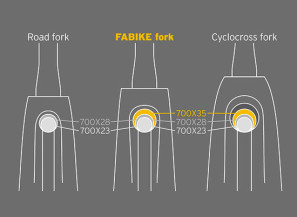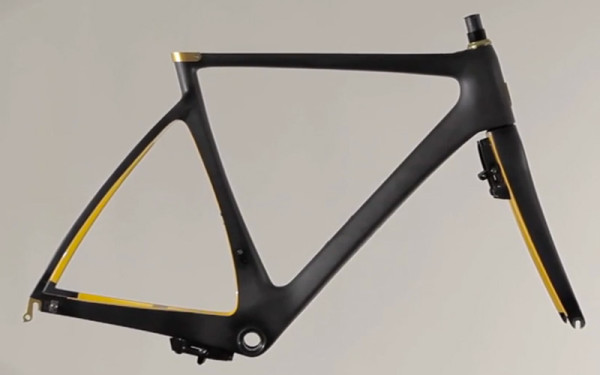After having met up with the head of FABike at the Dresden bike show a few months back, we arranged to give their bike an extended test to see how the crowdsourced project worked out. Designed in Italy, built in Taiwan, and assembled and distributed out of the Czech Republic, the FABike intended to be a multi-purpose road bike. The bike achieves its primary goal of flexibility through the use of an adjustable and interchangeable sliding dropout design that can be quickly and easily converted from a geared bike to singlespeed and from 130 to 120mm rear spacing and by accommodating up to 35mm tires (and thus gives the bike its name F+A+Bike.)
Find out more details, our initial setup, and some brief first impressions after the jump..
FABike mostly sells the bike as an extended frameset, since as a small company this gives a lot more flexibility and value to the end user. Their standard frameset includes the carbon frame with both interchangeable geared and singlespeed dropouts, their own matching full carbon tapered fork, their own produced linear pull aero brake calipers, and a matching anodized seatpost clamp. They also offer some other components that they produce, including fairly lightweight geared and singlespeed wheels with aluminum rims, a single ring chainring, and composite-railed saddle. All-in-all the flexibility of the frameset and the à la carte ordering makes it easy to build anything from a belt-drive commuter to a fat tire geared road bike.
I met up with company founder Fabio in Prague several weeks ago and he handed over a FABike test bike setup with their single front chainring and a SRAM 10speed cluster, a set of their wheels, and a value oriented road bar and post. He has been watching the growth of the gravel and mixed-surface road riding market with a lot of interest, since he has been developing this bike for over 3 years for just this type of capability, and really feels that the 1×10 or 1×11 drivetrain offers the best solution for this type of riding.
My first impressions of the bike were that in riding a single ring setup over varied terrain and road surfaces, it really is crucial to get a wide range cassette. The Force derailleur that was installed could handle up to a 30tooth cog, and the 12-27 cassette left me wanting on both the top and low end. But since the drivetrain is typically purchased separately, it’s just an important point for the buyer to optimize the gearing for their terrain and style. I’ve just switched out to some 11-28 and 12-30 cassettes and feel like this little change made a big difference. We’ll see more as I continue the test on several different types of wheels and tires.
The next big thing I’ve noticed was how big of a difference wheels and tires are going to make on this bike. On the first few rides commuting through the city and riding the surrounding roads, the large volume 35mm Schwalbe Marathon Racer tires helped take the edge off, but weren’t quite supple enough to balance the unforgiving aluminum wheels and stiff frame even at very low pressures. But no worries, we’ve got several wheelsets and tire combos lined up for this extended test, from cross tubulars on aluminum rims to lightweight low profile carbon tubulars and an assortment of clincher tires from 23-35mm wide.
A quick swap to some Challenge Grifo XS tubular tires on box section aluminum rims and a short dirt ride left a big smile on my face.
Tire choice looks to be one place where the versatility of this bike really shines.






